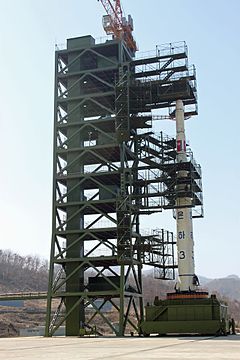National Aerospace Development Administration
| Korean spelling | |
|---|---|
| Korean alphabet : | 국가 우주 개발국 |
| Revised Romanization : | Gukgaujugaebalguk |
| McCune-Reischauer : | Kukkaujugaebalguk |
The National Aerospace Development Administration , or NADA for short (official name and abbreviation in English) is the national administration of North Korea that directs and leads all of the country's space development programs. The Korean name is 국가 우주 개발국 Kukkaujugaebalguk .
The current basis for the activities of NADA is the law on space development , which was passed in 2013 at the 7th session of the 12th Supreme People's Assembly. The law establishes the North Korean principles of the peaceful development of space, adherence to the principles of the Juche ideology and self-employment, and the goal of solving the scientific and technological problems of space travel in order to improve economy, science and technology.
The law also regulates the position of NADA and the principles of notification, security, research and, if necessary, compensation in connection with satellite launches. For cooperation with international organizations and other countries, the law requires the principle of equality and mutual benefit, compliance with international law and international regulations for space. The law also opposes the militarization of space.
logo
The emblem of NADA is a dark blue globe, below with the word Kukkaujugaebalguk (National Space Administration) in white Korean letters and above in light blue the letters DPRK for Democratic People's Republic of Korea and above the constellation Big Bear (Eng Dare). The big bear is said to symbolize the intention of the North Korean space explorers to glorify Korea Kim Il Sungs and Kim Jong Ils as a space power. In the middle it bears the letters “NADA” in white letters. Two light blue rings symbolize satellite orbits and the intention to place satellites on all orbits.
Korean Committee of Space Technology
North Korea's executive space agency is the Korean Committee of Space Technology , which has been researching and developing since the 1980s with the aim of manufacturing and placing communications satellites , Earth observation satellites, and weather observation satellites .
In August 1998, the agency launched the Kwangmyongsong-1 experimental satellite . North Korea used the Unha-2 missile launched from the Tonghae Satellite Launching Ground in Hamgyŏng-pukto Province .
Kwangmyongsong 3-2, first successful satellite launch
After failed launches in 1998, 2006, 2009 and April 2012, in which the rockets exploded or flew hundreds of kilometers but did not reach orbit, North Korea managed to place its first satellite in space on December 12, 2012, in the intended orbit. It was the Kwangmyongsong 3-2 satellite , which was launched into space by an Unha-3 rocket from the Sohae Space Center , Cholsan district.
International legal framework for North Korean space activities
In 2009, North Korea acceded to the Treaty on the Principles Regulating the Activities of States in the Exploration and Use of Outer Space, including the Moon and Other Celestial Bodies , and the Convention on the Registration of Objects Launched into Space .
Web links
Individual evidence
- ↑ KOREA NEWS SERVICE (KNS): National Aerospace Development Administration of DPRK from March 31, 2014 Juche 103; accessed on May 31, 2014 ( Memento from April 6, 2014 in the Internet Archive )
- ↑ Workers World: Despite Clinton, Korea has rights , Published Feb 25, 2009 2:38 PM, accessed May 30, 2014
- ↑ Josh Levs, CNN: N. Korea's launch causes worries about nukes, Iran and the Pacific , December 13, 2012 - Updated 2202 GMT (0602 HKT), accessed May 30, 2014
- ↑ KOREA NEWS SERVICE (KNS): KCNA Report on DPRK's Accession to International Space Treaty and Convention. March 12. 2009 Juche 98 ( memento of April 2, 2009 in the Internet Archive ) accessed on June 2, 2014
